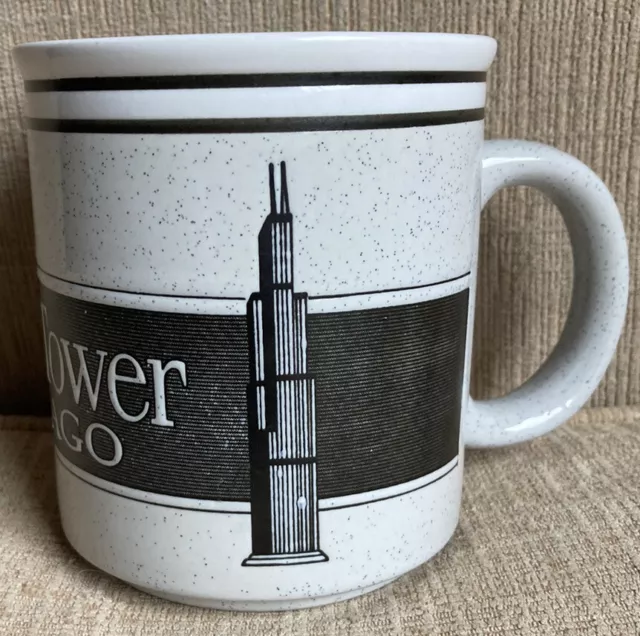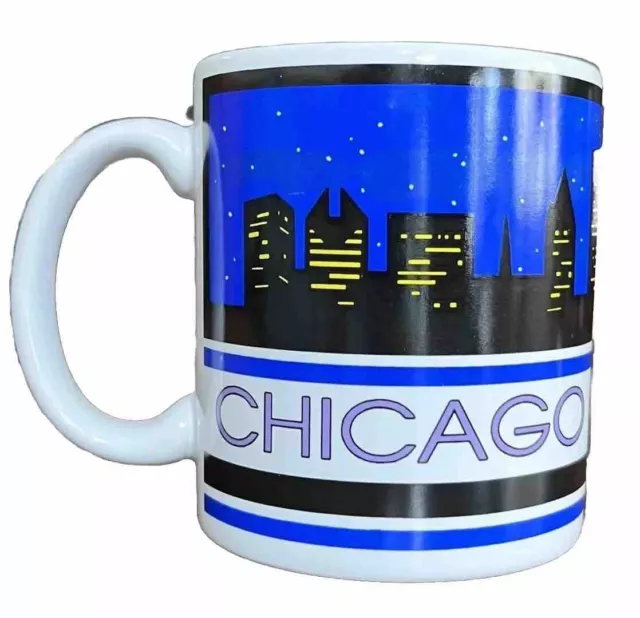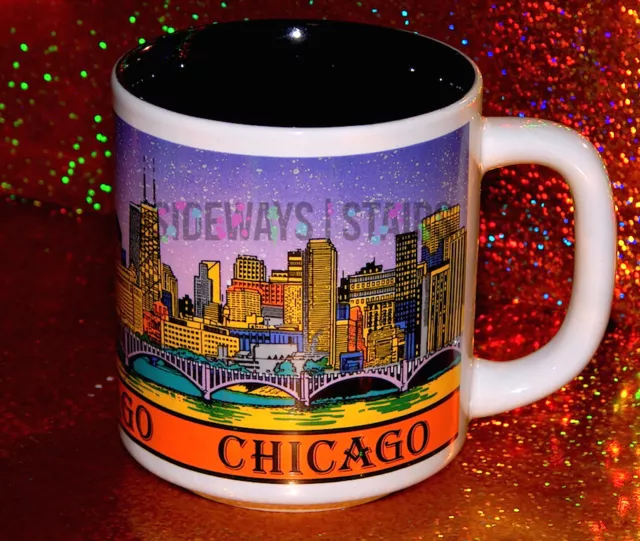VINTAGE CHICAGO SKYLINE MUG colorful night diamond building sears tower 90s rare
£48.18 Buy It Now or Best Offer, Click to see shipping cost, eBay Money Back Guarantee
Seller: sidewaysstairsco ✉️ (1,181) 100%,
Location: Santa Ana, California, US,
Ships to: US & many other countries,
Item: 192883791040
VINTAGE CHICAGO SKYLINE MUG colorful night diamond building sears tower 90s rare. Check out our other new & used items>>>>>HERE! (click me) FOR SALE: A vintage (early '90s) mug featuring a wonderful landscape image CHICAGO ILLUSTRATED SKYLINE DUSK/NIGHT SCENE MUG DETAILS: Display your Chicago love with a vintage mug! This souvenir mug features a very nice, pop art-style illustration of downtown Chicago. Included in the graphic is the Chicago River and bridge, and many of the recognizable downtown skyscrapers in various colors. In the skyline you'll notice Willis Tower (formerly Sears Tower), John Hancock Center, Crain Communications Building (formerly the Smurfit-Stone Building; also popularly known as the "diamond" or "vagina" building), and many more. The black inner provides some contrast and adds to the overall uniqueness of the mug design. Produced in the early 1990s (possibly late '80s). Dimensions: Height: approx. 3-3/4" Diameter: approx. 3-1/8" CONDITION: Pre-owned. The mug has acquired very minimal wear. The image looks great and the colors are vivid. Please see photos. *To ensure safe delivery the item will be carefully packaged before shipping.* THANK YOU FOR LOOKING. QUESTIONS? JUST ASK. *ALL PHOTOS AND TEXT ARE INTELLECTUAL PROPERTY OF SIDEWAYS STAIRS CO. ALL RIGHTS RESERVED.* "Chicago (/ʃɪˈkɑːɡoʊ/ (About this soundlisten), locally also /-ˈkɔː-/), officially the City of Chicago, is the most populous city in Illinois, as well as the third most populous city in the United States. With an estimated population of 2,716,450 (2017), it is the most populous city in the Midwest. Chicago is the principal city of the Chicago metropolitan area, often referred to as Chicagoland, and the county seat of Cook County, the second most populous county in the United States. The metropolitan area, at nearly 10 million people, is the third-largest in the United States, and the fourth largest in North America (after Mexico City, New York City and Los Angeles) and the third largest metropolitan area in the world by land area. Located on the shores of freshwater Lake Michigan, Chicago was incorporated as a city in 1837 near a portage between the Great Lakes and the Mississippi River watershed and grew rapidly in the mid-nineteenth century.[7] After the Great Chicago Fire of 1871, which destroyed several square miles and left more than 100,000 homeless, the city made a concerted effort to rebuild.[8] The construction boom accelerated population growth throughout the following decades, and by 1900 Chicago was the fifth largest city in the world.[9] Chicago made noted contributions to urban planning and zoning standards, including new construction styles (including the Chicago School of architecture), the development of the City Beautiful Movement, and the steel-framed skyscraper.[10][11] Chicago is an international hub for finance, culture, commerce, industry, technology, telecommunications, and transportation. It is the site of the creation of the first standardized futures contracts at the Chicago Board of Trade, which today is the largest and most diverse derivatives market gobally, generating 20% of all volume in commodities and financial futures.[12] O'Hare International Airport is the one of the busiest airports in the world, and the region also has the largest number of U.S. highways and greatest amount of railroad freight.[13] In 2012, Chicago was listed as an alpha global city by the Globalization and World Cities Research Network,[14] and it ranked seventh in the entire world in the 2017 Global Cities Index.[15] The Chicago area has one of the highest gross domestic products (GDP) in the world, generating $680 billion in 2017.[16] In addition, the city has one of the world's most diversified and balanced economies, not being dependent on any one industry, with no single industry employing more than 14% of the workforce.[17] Chicago's 58 million domestic and international visitors in 2018, made it the second most visited city in the nation, behind New York City's approximate 65 million visitors.[18][19] The city ranked first place in the 2018 Time Out City Life Index, a global quality of life survey of 15,000 people in 32 cities.[20][21][22][23][24] Landmarks in the city include Millennium Park, Navy Pier, the Magnificent Mile, the Art Institute of Chicago, Museum Campus, the Willis (Sears) Tower, Grant Park (Chicago), the Museum of Science and Industry, and Lincoln Park Zoo. Chicago's culture includes the visual arts, literature, film, theater, comedy (especially improvisational comedy), food, and music, particularly jazz, blues, soul, hip-hop, gospel,[25] and electronic dance music including house music. Of the area's many colleges and universities, the University of Chicago, Northwestern University, and the University of Illinois at Chicago are classified as "highest research" doctoral universities. Chicago has professional sports teams in each of the major professional leagues, including two Major League Baseball teams.... The destruction caused by the Great Chicago Fire led to the largest building boom in the history of the nation. In 1885, the first steel-framed high-rise building, the Home Insurance Building, rose in the city as Chicago ushered in the skyscraper era,[58] which would then be followed by many other cities around the world.[116] Today, Chicago's skyline is among the world's tallest and densest.[117] Some of the United States' tallest towers are located in Chicago; Willis Tower (formerly Sears Tower) is the second tallest building in the Western Hemisphere after One World Trade Center, and Trump International Hotel and Tower is the third tallest in the country.[118] The Loop's historic buildings include the Chicago Board of Trade Building, the Fine Arts Building, 35 East Wacker, and the Chicago Building, 860-880 Lake Shore Drive Apartments by Mies van der Rohe. Many other architects have left their impression on the Chicago skyline such as Daniel Burnham, Louis Sullivan, Charles B. Atwood, John Root, and Helmut Jahn.[119][120] The Merchandise Mart, once first on the list of largest buildings in the world, currently listed as 44th-largest (as of 9 September 2013), had its own zip code until 2008, and stands near the junction of the North and South branches of the Chicago River.[121] Presently, the four tallest buildings in the city are Willis Tower (formerly the Sears Tower, also a building with its own zip code), Trump International Hotel and Tower, the Aon Center (previously the Standard Oil Building), and the John Hancock Center. Industrial districts, such as some areas on the South Side, the areas along the Chicago Sanitary and Ship Canal, and the Northwest Indiana area are clustered.[122] Chicago gave its name to the Chicago School and was home to the Prairie School, two movements in architecture.[123] Multiple kinds and scales of houses, townhouses, condominiums, and apartment buildings can be found throughout Chicago. Large swaths of the city's residential areas away from the lake are characterized by brick bungalows built from the early 20th century through the end of World War II. Chicago is also a prominent center of the Polish Cathedral style of church architecture. The Chicago suburb of Oak Park was home to famous architect Frank Lloyd Wright, who had designed The Robie House located near the University of Chicago.[124][125] A popular tourist activity is to take an architecture boat tour along the Chicago River." (wikipedia.org) "The buildings and architecture of Chicago have influenced and reflected the history of American architecture. The built environment of Chicago is reflective of the city's history and multicultural heritage, featuring prominent buildings in a variety of styles by many important architects. Since most structures within the downtown area were destroyed by the Great Chicago Fire in 1871 (the most famous exception being the Water Tower)[1] Chicago buildings are noted for their originality rather than their antiquity. Chicago is world-famous for its plethora of unique architectural styles, from Chicago Bungalows and Two-Flats to the grand Graystones along Logan Boulevard and Lawndale Avenue, from the skyscrapers of the Loop as well as a wealth of sacred architecture such as the city's ornate "Polish Cathedrals".... Beginning in the early 1880s, architectural pioneers of the Chicago School explored steel-frame construction and, in the 1890s, the use of large areas of plate glass. These were among the first modern skyscrapers. William LeBaron Jenney's Home Insurance Building was completed in 1885 and is considered to be the first to use steel in its structural frame instead of cast iron. However, this building was still clad in heavy brick and stone. The Montauk Building,[2] designed by John Wellborn Root Sr. and Daniel Burnham, was built from 1882 to 1883 using structural steel. Daniel Burnham and his partners, John Welborn Root and Charles Atwood, designed technically advanced steel frames with glass and terra cotta skins in the mid-1890s, in particular the Reliance Building;[3] these were made possible by professional engineers, in particular E. C. Shankland, and modern contractors, in particular George A. Fuller. Louis Sullivan was perhaps the city's most philosophical architect. Realizing that the skyscraper represented a new form of architecture, he discarded historical precedent and designed buildings that emphasized their vertical nature. This new form of architecture, by Jenney, Burnham, Sullivan, and others, became known as the "Commercial Style," but it was called the "Chicago School" by later historians. In 1892, the Masonic Temple surpassed the New York World Building, breaking its two-year reign as the tallest skyscraper, only to be surpassed itself two years later by another New York building. Since 1963, a "Second Chicago School" emerged from the work of Ludwig Mies van der Rohe at the Illinois Institute of Technology in Chicago. The ideas of structural engineer Fazlur Khan were also influential in this movement,[4] in particular his introduction of a new structural system of framed tubes in skyscraper design and construction. The first building to apply the tube-frame construction was the DeWitt-Chestnut Apartment Building which Khan designed and was completed in Chicago by 1966.[5] This laid the foundations for the tube structures of many other later skyscrapers, including his own constructions of the John Hancock Center[6] and Willis Tower (then named the Sears Tower)[7] in Chicago and can be seen in the construction of the World Trade Center, Petronas Towers, Jin Mao Building, and most other supertall skyscrapers since the 1960s.[8] Willis Tower would be the world's tallest building from its construction in 1974 until 1998 (when the Petronas Towers was built) and would remain the tallest for some categories of buildings until the Burj Khalifa was completed in early 2010.... 1940 to the present: 1940-1942 St. Wenceslaus church, 3400 N. Monticello Ave, McCarthy, Smith and Eppig 1952 860–880 Lake Shore Drive, Ludwig Mies van der Rohe 1957 Inland Steel Building, Bruce Graham and Walter Netsch, Skidmore, Owings & Merrill, 1964 Marina City, Bertrand Goldberg 1968 Lake Point Tower, John Heinrich and George Schipporeit 1968 Seventeenth Church of Christ, Scientist. Harry Weese 1969 John Hancock Center, Bruce Graham, Skidmore, Owings & Merrill 1973 330 North Wabash, Ludwig Mies van der Rohe 1974 Willis Tower, Bruce Graham, Skidmore, Owings & Merrill (previously the Sears Tower) 1974 Aon Center, Edward Durrell Stone (earlier names were Standard Oil Building and Amoco Building) 1977 St. Joseph the Betrothed Ukrainian Greek Catholic Church 1979-85 James R. Thompson Center, Helmut Jahn 1989 NBC Tower, Skidmore, Owings & Merrill 1990 American Medical Association Building, Kenzo Tange 1990 Athletic Club Illinois Center, Kisho Kurokawa 1991 Harold Washington Library Center, Thomas Beeby 1991 U.S. Cellular Field, Home of the White Sox 1991 Museum of Contemporary Art, Josef Paul Kleihues 1992 77 West Wacker Drive, Ricardo Bofill 2004 Millennium Park, Frank Gehry, Kathryn Gustafson, Anish Kapoor, Jaume Plensa, and others, a showcase for 21st century modernism. 2009 155 North Wacker, Goettsch Partners 2009 Trump International Hotel and Tower, Skidmore, Owings & Merrill 2010 Aqua Tower, Studio Gang Architects" (wikipedia.org)
- Condition: Used
- Condition: In very good, pre-owned condition. Please see photos and description.
- Country/Region of Manufacture: Unknown
PicClick Insights - VINTAGE CHICAGO SKYLINE MUG colorful night diamond building sears tower 90s rare PicClick Exclusive
- Popularity - 0 watchers, 0.0 new watchers per day, 1,836 days for sale on eBay. 0 sold, 1 available.
- Best Price -
- Seller - 1,181+ items sold. 0% negative feedback. Great seller with very good positive feedback and over 50 ratings.
People Also Loved PicClick Exclusive

Vintage Chicago Sears Tower Souvenir Building Skyscraper acrylic Paperweight
£17.30 Buy It Now 29d 21h
Ashtray souvenir Chicago Skyline Glass TRAY sears tower vintage Illinois EUC
£7.99 Buy It Now 1d 19h
Chicago Sears Tower Souvenir Coffee Tea Mug Embossed Stoneware Japan Vintage
£13.49 Buy It Now 26d 5h
Vintage Chicago Sears Tower Coffee Mug Travel Tourist Souvenir Speckled Cup EUC!
£14.46 Buy It Now 3d 20h
Vintage Chicago City Skyline Souvenir Plate Porcelain Standard Oil Sears Tower
£43.15 Buy It Now 14d 11h 8 watchers
8 watchersRainbow Vintage Chicago Skyline Mug Pride Coffee Tea Cup Rare LGBTQ IDC brand
£11.57 Buy It Now or Best Offer
Ambesonne Americana Art Ceramic Coffee Mug Cup for Water Tea Drinks, 11 oz
£17.34 Buy It Now
Chicago Skyline Souvenir Colorful Ceramic Tea Coffee Mug
£9.63 Buy It Now
Vintage 90’s Chicago Night Skyline Mug Papel No. 47692 Thailand
£9.64 Buy It Now or Best Offer


